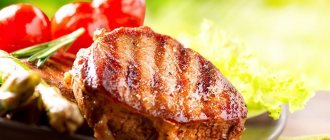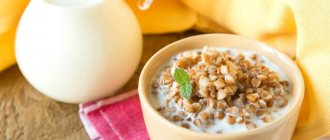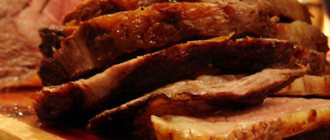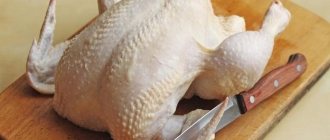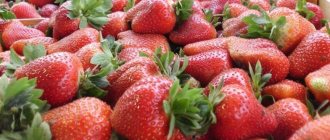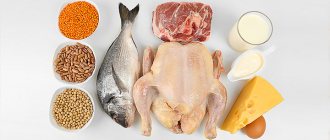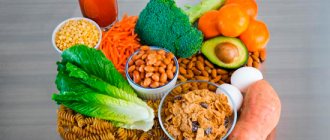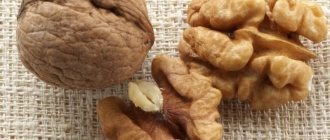The benefits of lean meat
Meat products contain animal protein, which is the main component of tissues and cells. In addition to protein, meat is rich in phosphorus, potassium, iron, vitamins, and amino acids. Low-fat varieties contain virtually no harmful cholesterol that can negatively affect blood vessels and the heart.
They are indicated during long-term diets to maintain muscle mass. Collagen contained in lean deli meats is involved in the formation of cells in joints, skin, and blood vessels.
Boiled lean red meat and broths based on it are especially useful. It increases hemoglobin and supports the skeletal system.
Beef composition
The fact that beef is a valuable source of healthy protein is an indisputable fact. Beef protein is very easily absorbed by the body. Beef contains less fat than chicken, so it is especially valued by nutritionists and athletes and helps in gaining muscle mass.
100 grams of beef contains:
- fats - 4.99 g;
- proteins - 22.03 g;
- carbohydrates - 0.05 g;
- water - 72.30 g;
- ash - 1.05 g.
Vitamins:
- Vitamin A - 2.0 mcg;
- Vitamin D - 0.1 mcg;
- Vitamin D3 - 0.1 mcg;
- Vitamin E - 0.2 mg;
- Vitamin K - 1.4 mcg;
- Vitamin B1 - 0.1 mg;
- Vitamin B2 - 0.2 mg;
- Vitamin B3 - 5.6 mg;
- Vitamin B4 - 65.7 mg;
- Vitamin B5 - 0.6 mg;
- Vitamin B6 - 0.6 mg;
- Vitamin B9 - 5.0 mcg;
- Vitamin B12 - 2.3 mcg.
Microelements:
- calcium - 12.0 mg;
- iron - 2.1 mg;
- magnesium - 19.0 mg;
- phosphorus - 205.0 mg;
- potassium - 330.0 mg;
- sodium - 63.0 mg;
- zinc - 5.1 mg;
- copper - 0.1 mg;
- selenium - 25.4 mcg.
Beef is a good source of elastin and collagen, which are the main builders of joint tissue. Therefore, to prevent joint diseases, it is worth eating beef.
Meat Diet Basics
An adult should eat at least 130-150 grams of meat daily. Of course, it is desirable that the product be non-greasy. Lenten varieties include:
Veal is considered a dietary type of meat with a minimum of fat, especially when boiled. But this does not mean that during the diet they eat it in unlimited quantities.
Chicken is also a low-fat variety. It contains useful amino acids and is easier to digest compared to beef and pork. Chicken broth is used to make nutritious borscht and soups.
Turkey is a healthy type of meat, containing the most vitamins, minerals, protein and a minimum of cholesterol. It is rich in manganese, iron, calcium, sulfur, and potassium. Dishes with boiled or oven-cooked turkey are a means of preventing vascular pathologies, osteochondrosis and osteoporosis.
Rabbit meat is a dietary low-calorie meat that can also be given to children with allergies. The small muscle fibers of rabbit meat are easily digestible. It is useful after long-term illnesses, as it strengthens a weakened body. There are no contraindications to including rabbit meat in the diet menu.
Horse meat is an exotic meat. In terms of amino acid composition, it is a perfectly balanced meat delicacy. Compared to beef, horse meat protein is digested much faster. There is minimal concentration of fat in horse meat. Horse meat dishes do not contain vitamin A and nourish cells with iron, neutralizing harmful components. Horse meat must be of high quality and fresh, since bad meat contains a lot of carbohydrates and pathogenic bacteria.
Features of eating meat
When following a diet, you cannot stop eating protein foods, especially meat. Hemoglobin may drop, heart problems will appear, bones will become less dense, but the meat must also be prepared and chosen correctly.
Lean veal does not harm your figure. You can prepare dishes from roast beef, sirloin and steak. It is better to avoid ribs and fatty entrecote, which contain layers of fat.
The best veal is cooked on the grill or in the oven.
It is better not to serve hearty horse meat in the evening. Its useful components will come in handy for lunch. When it comes to chicken, it is better to give preference to brisket, and it is better to forget about fried legs and wings. These are the fattest parts of chicken. The chicken breast is baked in foil, grilled without oil, and stewed with vegetables.
Boiled meat is served without fatty broths and sauces with vegetables:
- all varieties of cabbage; Read more about the diet on different types of cabbage in the article https://mikrosovet.ru/kapusta-dlya-pokhudeniya.html
- green beans;
- zucchini;
- celery;
- green peas;
- carrots;
- paprika;
- tomatoes.
They are served stewed, mashed or raw. It is advisable to exclude salt from the menu. The meat is seasoned with different spices for taste. It is better not to mix meat with potatoes, pasta, rice or cereals. These are dishes that are hard on the stomach.
https://youtu.be/F5o4RdQBuH4
Even if you follow a special diet, you cannot give up meat, since it is an important source of iron, potassium, proteins and other trace elements.
This is especially true for people with health problems or those who regularly exercise and need constant vitamin supplementation.
When following a diet, it is necessary to replace all types of fatty poultry and fish with dietary meat with a reduced fat content, choosing the healthiest one.
Table of dietary meat, calorie content and nutritional value
Each type of meat has a different BJU ratio and calorie content.
The most common types of meat and their energy value:
| Type | Squirrels | Fats | Carbohydrates | Number of calories per 100 g |
| Pork | 16 | 30 | 333 kcal | |
| Beef | 20 | 12,5 | 188 kcal | |
| Chicken | 20 | 9 | 1 | 165 kcal |
| Veal | 20 | 1 | 91 kcal | |
| Mutton | 25 | 20 | 295 kcal | |
| Rabbit meat | 21 | 12 | 200 kcal | |
| Turkey meat | 22 | 12 | 1 | 197 kcal |
| horsemeat | 20 | 7 | 145 kcal | |
| Duck | 16 | 60 | 369 kcal | |
| Goose | 16 | 34 | 364 kcal |
Thus, the least nutritious from a dietary point of view are duck and goose, and it is best to avoid them during the diet.
Veal
According to the calorie table, veal is one of the lowest calorie types of meat.
Regular consumption of this meat in food will reduce the calorie content of dishes and help saturate the body with iron.
It must be remembered that eating only red meat increases the risk of developing malignant tumors. The best option would be to alternate veal with other varieties.
horsemeat
One of the best, but less affordable options for weight loss. Horse meat is difficult to obtain, but it is a storehouse of protein and fat, amino acids, phosphorus, calcium, and magnesium.
It contains no cholesterol, making it ideal for diabetics and people with vascular diseases. Horse meat has one disadvantage - a sharp, specific taste and smell, which repels many.
Chicken
An ideal option for adherents of proper nutrition and people with poor health. Chicken is the most affordable meat, rich in vitamins A, E and C. It is quickly digested and does not contain many carbohydrates.
Tip: If you want to reduce the calorie content of chicken meat, it is better to remove the internal organs and remove the skin.
Chicken is easy and quick to prepare. It requires minimal processing time and goes well with any product.
Beef
Beef is rich in fluorine, magnesium and potassium and has a pleasant taste. Nutritionists recommend including it in the weekly menu. Regular consumption of veal in the diet helps normalize digestion.
Thanks to the presence of zinc, it improves blood circulation and is suitable for people with vascular diseases.
The only negative is the long and labor-intensive processing process.
Turkey
Not the lowest calorie meat, but the presence of fluoride and a reduced percentage of animal fat make it useful for those losing weight. By adding turkey meat to your diet, you can compensate for the lack of phosphorus, fluorine, vitamins B and P in the body.
If you follow a strict regime, it is recommended to cook the breast: it contains less fatty tissue.
It is better to avoid poultry skin.
Beef harm
Despite many beneficial properties, beef can sometimes cause harm to the body. For example, scientists around the world believe that beef meat, more than any other meat, contributes to the development of colon cancer when consumed regularly or excessively.
What the animal was fed also matters:
- Nowadays, most pets are fed special food.
- Animals may not see clean meadows and fields in their entire lives.
- Harmful elements contained in animal feed naturally enter our body along with meat and can negatively affect it.
Harmful effects may also be due to the method of preparing meat. It is believed that fried beef, due to the resulting carcinogens, does more harm than good, although it is tasty. Purine bases in beef may contribute to the development of gout.
Recipes for preparing dietary meat dishes
To eat meat on a diet and not gain weight, it is important to choose the right type and cook it correctly.
For those who adhere to a healthy diet, it is best to avoid frying in vegetable oil, in batter and on the grill: this increases the calorie content of the product.
It is better to bake the dish in the oven and steam it with vegetables. An inexpensive diet menu can be quite varied. The most common are meat salads, meatballs, soups, low-fat cutlets, and casseroles.
Warm salad with chicken
To prepare a simple and tasty salad with vegetables and chicken, you will need boiled poultry breast. Thighs and wings can be used, but they contain more fat.
Preparation:
- It is necessary to boil a brisket weighing 200 grams, cut into pieces.
- Take 300 grams of broccoli, two carrots, chop and simmer in a frying pan for 15 minutes.
- Add the brisket and simmer for another 10 minutes.
- At the end, sprinkle the finished salad with lemon juice, pour over a spoon of olive oil and serve warm.
Turkey meatballs
To prepare turkey meatballs, you will need 500 g of poultry fillet, onions, garlic, zucchini, celery, and a medium carrot.
Preparation:
- Grind the fillet along with the onion in a meat grinder, throw in the garlic, celery and a couple of zucchini, then grind again.
- Pour 3 tbsp into the prepared minced meat. l. oatmeal, salt, make small meatballs.
- Pour sunflower oil, chopped onions and carrots into a pan, fry over low heat, add meatballs, add water and simmer for half an hour.
- Serve with greens.
Beef with vegetables
To prepare a classic dish you will need 450 g of beef, a tomato, a carrot, an onion.
Preparation:
- Separate the fat and remove the film, cut into large pieces, lightly beat and rub with salt and spices.
- Place the beef in a heated frying pan, add vegetable oil, leave to simmer for 10 minutes, add water and leave for another 15 minutes.
- Chop the onion, grate the carrots, 2 tomatoes, add a glass of water, 150 ml of milk and 1 tsp. lemon.
- Pour the resulting sauce over the dish and simmer for 2-4 minutes. Serve with fresh herbs.
Rabbit in sour cream
To prepare a dietary rabbit, you will need the following ingredients: 600 g fillet, 3 onions, 2 carrots, 500 g champignons, eggplant, spices.
Preparation:
- The rabbit meat must be finely chopped and marinated using a mixture of apple cider vinegar, rosemary and spices. Leave to soak in the marinade for 2 hours.
- Chop onions, carrots, mushrooms, fry in sunflower oil.
- Remove the rabbit and lightly fry it in another pan.
- Place fillet, mushrooms with onions and carrots, and diced eggplants in layers in a deep saucepan. Sprinkle salt, spices and chopped garlic on top.
- Pour water over everything and leave to simmer for 30-40 minutes.
- Add 400 g of sour cream to the pan and leave for another 10 minutes.
- Serve with greens.
Meat in French
To prepare a low-fat version of the famous dish, it is better to use chicken: this way the caloric intake will be reduced to 190 kcal.
Preparation:
- 500 g of chicken fillet should be cut into thin pieces and placed in a bowl.
- In a separate plate, mix 1 chicken egg, add salt and pepper, pour the mixture over the fillet and leave to soak for 15 minutes.
- Cut tomatoes into circles, grate low-fat cheese.
- Lay out the fillet pieces, put tomatoes on top, pour over low-fat yogurt and sprinkle with cheese.
- Bake the dish for half an hour at 180 degrees.
Tip: chicken burns easily, you can avoid this by lining the baking sheet with baking paper or greasing it with olive oil.
LiveInternetLiveInternet
Beef carcass cutting
This is the simplest carcass cutting scheme
Even inexperienced amateur chefs are well aware that one of the criteria responsible for the tenderness of various cuts of beef is the ability to select the right cut from the cut of the carcass. Pieces of meat from the middle part of the back (muscles that only support the body and are not involved in movement are located here) have a more delicate structure.
The entrecote and sirloin parts taken from here, including sirloin and thick edge, are excellent for preparing many dishes, including steaks. In the forearm, thigh, chest and rib cuts, the connective tissue, on the contrary, is highly developed. The average development of connective tissue is in the dorsal and scapulocervical cuts. The meat from the back of the carcass is more tender and is well suited for frying and grilling, while the meat from the front has a strong flavor, is tougher and requires slow cooking with the addition of liquid.
There are different ways to cut beef: American, British, Dutch, Italian, German, Danish, Australian and South American.
American way of cutting a carcass
British way of cutting a carcass
The Dutch way of cutting a carcass
The South American scheme is also common, in which the entire carcass is divided into 19 numbers, let's look at this scheme in more detail
Front cut:
No. 1 - entrecote on the bone (Cube Roll) No. 2 - thick edge (Ribs) No. 3 - brisket (Brisket) No. 4 - shoulder blade (Shoulder) No. 5 - shoulder-shoulder part (roast shoulder) No. 6 - false fillet (Blade) No. 7,8 - shank (Shank) No. 9 - thin edge (Thin ribs) No. 10 - neck (Neck) Rear cut:
No. 11 - thick fillet (flat roast beef) (sirloin) No. 12 - fillet (tenderlion) No. 13 - rump, rump No. 14 - upper part of the rump (Top rump, Nuss - German) No. 15 - tenderloin flesh (Silver side ) No. 16 - inner part of the hip cut (Top side) No. 17 - flank (flank) No. 18 - rear ankle (shank) No. 19 - white meat for roast (Weiß Braten)
If you buy, for example, frozen meat in a supermarket, there is always a number on it, and you know exactly which part you are purchasing. But alas, even here, there are differences in the number distribution system.
And when buying at the market, it is still advisable to know why you need a piece of meat, what part of the carcass it comes from and what this part is called.
Russia has adopted its own scheme for cutting beef carcasses (by the way, not much different from those given above) and its own terminology, which will be useful for all avid meat eaters to know: 1-2. Neck (upper and lower parts) - this meat is classified as second grade, it is better to buy it in the form of minced meat. The lower part of the neck used to be called the hryvnia, and the upper part was called the zarez. 3. Shoulder - this meat is classified as the first grade, it is quite suitable for stewing (goulash, stew) and frying, but requires a long preparation. 4-5. The rib portion (thick edge) is first-class meat, in its entirety it consists of 13 ribs: the first 3 are attached to the lower part of the shoulder blade, they are removed; the next 4 ribs are usually sold as a whole piece, which is cooked as bone-in meat, but the bones can be cut off and cooked into a roll; the next 3 ribs contain more meat; the remaining ribs are a rather expensive cut of tender meat. 6. Loin (thin edge, roast beef) - a first-class cut of tender meat that can be fried and grilled; in the middle of this part there is a tenderloin (sirloin). 7. Rump is a premium lean meat for frying and grilling. 8. Ham (rump, thigh) - first-class meat, a lean cut, which is well suited for stewing in a pot and for rare steak; This part of the carcass can be salted, stewed or fried. The part closest to the tail is called the “pink” and is used for roasting. 9. Shank - lean beef of the third grade, intended for stewing (the name refers only to the hind leg) or for cooking broth. 10-11. Barrel (flank) is a fairly cheap second-class meat, used for stews or stewing. 12. Upper rib part (edge) - lean meat; it is freed from bones, rolled into a roll and used, for example, for stewing in a pot. 13. Brisket - first-class meat; It is sold boneless in the form of a roll and is suitable for boiling, stewing, soups (for example, for pickle), in stews and pilaf. 14. Knuckle is a third-grade meat that requires long cooking (the name refers only to the front leg).
A few words about the juiciness of beef - probably some former meat-eaters have switched to the enemy camp of vegetarians, having dislocated their jaws in an attempt to chew a sole-shaped entrecote or broken a tooth on a granite steak... Supporters of low-fat diets will have to come to terms with the fact that the juiciness of beef (alas!) directly depends on its fat content. In one of the best varieties of American beef, called “marble beef,” lean flesh alternates with the finest fatty streaks—they make the taste of the meat so juicy and tender.
The method of frying is of great importance for the juiciness of meat. The more moisture the meat loses in the pan, the drier and tougher it becomes. Therefore, you should not cook excellent tenderloin in fat or oil - fresh, juicy meat is best fried in a dry, hot frying pan for several minutes on both sides, and salt each side only after browning. By the way, it is best to pound beef on a board moistened with cold water, since dry wood absorbs meat juice.
For preparing meat dishes, it is best to consume meat from young animals. It is easy to distinguish by color. The meat of animals under six weeks of age is light pink to light red in color and has dense white internal fat. Young meat (up to two years old) is light red in color with almost white fat. The meat of adult animals (two to five years old) is juicy, tender, and red in color. Old animals (over five years old) have dark red meat and yellow pork fat. Beef obtained from animals under five years of age has the best nutritional properties, pork - from animals 7-10 months of age, and lamb - from animals 1-2 years old.
Benign meat is covered with a thin crust of pale pink or pale red color and does not stick to the fingers in the places of cuts. When you feel its surface, your hand remains dry, and the pits caused by finger pressure quickly disappear. To determine the freshness of meat, you can pierce it with a heated knife or fork. If it is of poor quality, the knife or fork will acquire an unpleasant odor.
Figure - Scheme of cutting beef carcass (high-quality cuts)
Table - Description of beef carcass cutting parts
1[/td]
| № | Name of the carcass cutting part (cuts) | Variety | Characteristics, features of the carcass part | Purpose of the carcass part |
| Neck, cut | 3 | It contains a considerable amount of tendon, but has good taste. | Cooking (including long-term cooking), stewing. Dishes: seasoning soups and broths, minced meat, cutlets, goulash, cholent, jellied meat (jelly). | |
| 2 | Dorsal part (thin edge, thick edge, entrecote) | 1,2 | May be sold with bones. The thick end is soft, fine-fiber meat and contains 4.5 ribs. The thin edge has excellent taste and contains 4.5 ribs. Entrecote is a selected soft intercostal part of meat located along the vertebrae. | Frying, baking (including large pieces), stewing. Dishes: soups (ribs), chopped cutlets, goulash, roast, steak (thin edge), roast beef (thin, thick edge), rib meat, entrecote. |
| 3 | Thick fillet, sirloin | 1 | Tender meat, thin layers of fat. | Frying (including fast), stewing. Dishes: cutlets, meatballs, meatballs, steak, beef stroganoff (top part of the rump), zrazy, rolls, various minced meats and fillings. |
| 4 | Tenderloin, sirloin | 1 | The most valuable and tender part of meat, lean, without streaks | Frying, baking in pieces. Good for grilling. Dishes: roast beef, steak, chops, kebab, azu. |
| 5 | Kostrets | 1 | It is distinguished by its softness. Good taste. The inside is the most valuable. | Stewing, boiling, frying, minced meat, baking. Dishes: cutlets, meatballs, beef stroganoff (inner part), soup, broth. |
| 6 | Rump (mid thigh), probe (inner thigh), cut (lower thigh) | 1 | Lean, fine-fiber meat, good taste. | Stewing, boiling, baking. Dishes: cutlets, roast beef, soups, broths. |
| 7 | Peritoneum, flank (curl) | 2 | The consistency of the meat is rough, but the taste is not bad. May contain fat, bones, cartilage and films. | Minced meat, boiled. Dishes: meatballs, meatballs, roll, soups, zrazy, borscht, broth. |
| 8 | Edge edge | 1 | Meat contains layers of fat. It has excellent taste. | Boiling, stewing, minced meat. Dishes: goulash, azu, cutlets, dressing soups. |
| 9 | Spatula | 2 | The fibers are a little rough. The shoulder part is lean meat and may have thick veins. | Cooking, stewing, minced meat. Dishes: steak, goulash, azu, chopped cutlets, roll. |
| 10 | Brisket | 1 | The meat has a layered structure and contains layers of fat. Good taste. | Boiled, stewed, baked, chopped (stuffed). Dishes: roasts, soups, borscht. |
| 11 | Underthigh | 3 | Not the best consistency, but has a good taste and aroma (thanks to gelatin). | Slow frying and stewing in large pieces. Dishes: goulash, azu, soups. |
| 12 | shank | 3 | Lots of tendons and connective tissues. Contains marrow and gelatin. Good taste. Stickiness after cooking. | Slow cooking. Dishes: broths, jellies (jellied meat). Possibly made from pulp: balls, cutlets, meatballs, rolls, etc. |
| 13 | Knuckle | 3 | The same as for the shank. | Like a shank. |
Like any meat, beef is best stored in the refrigerator.
The shelf life of frozen beef is slightly longer than that of pork and lamb - about 10 months. Veal - 8 months.
The duration of beef maturation after slaughter is approximately 2 weeks at a temperature of 1-2 degrees Celsius. As the storage temperature increases, the ripening time also increases. Without the use of a refrigerator, the meat will ripen within a few days, but in this case the shelf life will be sharply reduced.
This cutting scheme is also common on the Internet.
1. Sirloin. This cut includes the last two dorsal vertebrae with their corresponding ribs without the lower third and the first five lumbar vertebrae. The muscle tissue of the fillet is distinguished by its exceptional tenderness and fine-fiber structure, especially the internal lumbar muscles (tenderloin), located from the 1st lumbar vertebra to the ilium. As a rule, at meat processing plants, the tenderloin is separated and sold as a semi-finished product at a price higher than first-grade meat. Rump steaks, kebabs, roast pieces, and boiled meat are prepared from the muscle tissue of the sirloin.
2. Butt. This cut contains a large amount of tender meat on the last three ribs. The sirloin can be roasted whole, with or without bones, or cut into portions for frying steaks over an open fire or in a frying pan. Sirloin fillet steak is prepared without bones; To prepare a steak with a bone, the meat is cut from the front part of the rib along with the rib: the steak from the back lumbar part of the rib contains a piece of tender tenderloin that runs under the spine. If the tenderloin is cooked separately, it can be roasted whole, but most often it is cut into pieces against the grain to prepare steaks.
3. Rump. A varietal cut containing the lower vertebrae of the spine and the pelvic bone. All bones are usually removed and the meat is cut across the grain into portions to create tender steaks with excellent flavor. Rump steaks can be fried over an open fire or in a frying pan. Cuts weighing more than 1.5 kg make excellent roast beef, which is usually cooked over high heat.
4. Edge. Thick edge. A cut containing 4 or 5 ribs with relatively soft and fine-fiber meat. To prepare excellent roast beef, the ribs are usually cut short and the meat is tied; the bones can be removed completely; in this case, the meat is rolled into a roll before tying. The meat can also be used for stewing or baking in large pieces. Thin edge. A cut with 4 or 5 ribs that is typically used to produce roast beef that is two or three ribs thick. The thin-edged meat is very tender and ideal for roast beef. To preserve the aroma and juiciness, the thin edge should be baked in the oven along with the bones at high temperature, having first sawed through the upper parts of the dorsal vertebrae. Both thin-cut steaks and rib meat cooked on the grill are excellent in taste.
5. Little man-falcon. The front thickened part of the brisket (at the level of five ribs), called the chelishko-sokolok, is the most valuable in nutritional terms, used for preparing fatty and aromatic cabbage soup, borscht and broths.
6. Rump. Rump is a cut of meat between the sacrum and the pelvic bone that has excellent qualities. Most often, this meat is used to prepare high-quality rotsbeef by slow roasting.
7. Brisket. After removing the breast bone and ribs, a long, flat piece of meat is left, which is usually rolled up and tied. Pieces of the required length are usually cut from it and sold. The layered structure of the muscle tissue of the brisket is emphasized by layers of fat, and the taste is good. Brisket needs to be cooked in a moist environment. Sometimes it is stewed, but more often it is boiled - either fresh or salted (brisket is traditionally used for pickling).
8. Winner and probe, rump, cut. These four cuts together make up the upper part of the hind leg. Shchup - a cut of lean, fine-fiber meat from the inside of the thigh - is good for slow frying and stewing. The meat of the cut is a little rougher, but also has good taste and is usually used for slow frying or stewing, as well as for pickling and boiling over low heat. Most often, this meat is used to prepare high-quality rotsbeef by slow roasting. Podbederok is good for slow frying and stewing in a large piece, but quite often it is cut into portions that are stewed or fried in a frying pan.
9. Flank. This cut consists of muscle tissue covering the ribs with layers of fat. Excellent meat for cooking. because it has good taste, and the layers of fat in it help retain moisture. Meat can also be stewed with or without bones, cut into slices or cubes. Quite often, the edge is used to prepare minced meat.
10. Shoulder blade. The shoulder bone contained in the cut is removed by the butcher, and the meat is cut into portions for preparing steaks or for stewing. The taste of the meat is high, the fat content is relatively low. Some cuts have thick veins of connective tissue that attach the muscles to the shoulder blade bone. This connective tissue is left on the meat because it softens when cooked in moist heat, releasing sticky substances into the broth.
11. Neck. Neck meat contains a large percentage of connective tissue and therefore, to acquire the required softness, it requires long-term heat treatment in a humid environment. However, it has good taste and is inexpensive. Neck meat is usually sold diced or minced.
12. Knuckle. The muscular foreleg (knuckle) contains the medulla and several narrow, distinct muscles with a thick layer of connective tissue and tendons. After removing the bone, the meat is usually cut into slices across the grain or into cubes for stewing. When cooked in a moist environment, the gelatin of the connective tissues decocts, forming a very tasty and nutritious gravy. The shank is especially suitable for preparing French beef stew.
13. Cut. The muscle tissue of the butt is dark red, coarsely fibrous, with a large amount of connective tissue. It is used to prepare broths, jellies, and minced meat.
14.15. Shank. The tendon-rich, fleshy part of the hind leg: similar to the knuckle, it contains marrow bone and a large percentage of connective tissue. Typically the bone is removed and the meat is cut into thick slices or cubes. The delicate aroma and high gelatin content give this meat excellent taste when stewed.
Let's summarize our knowledge:
BEEF FOR COOKING:
- broth - bones;
- broth and boiled meat - rump, sirloin, brisket, shank, shank, flank;
- meatballs - grade III meat. BEEF FOR ROASTING:
- entrecote - thick and thin edge;
- brizolya - tenderloin;
- beefsteak - tenderloin, thick and thin edge;
- splint - tenderloin;
- rump steak - tenderloin, sirloin, rump;
- rozbratela - thick and thin edge;
- beef stroganoff - tenderloin, sirloin, rump;
- chopped cutlets - shoulder blade, thigh. BEEF FOR BAKED DISHES:
- baked meat - rump or rump:
- roast beef in English - sirloin;
- tenderloins in English - tenderloin;
- roll - shoulder blade, thigh. BEEF FOR STEW:
- goulash - shoulder, shank, shank, neck, rump, thigh, rump;
- roast - rump or rump, shoulder blade;
- stufata - rump or rump, shoulder blade;
- roll - rump or rump, shoulder blade;
- for the chops - rump or rump, thigh, thick and thin edge;
- immediately chopped - a spatula. BY-PRODUCTS:
- boiled - tripe, tongue, salted tongue, heart;
- fried - brains, liver;
- stewed - kidneys, heart goulash.
Another source and another diagram:
1 – head, 2 – neck, notch, 3 – sirloin, 4 – cap, 5 – thick edge, 6 – middle of the shoulder blade, 7 – thin shoulder blade, shank, 8 – thin edge, 9 – hem from the edge, 10 – sternum, 11 – thin sirloin, 12 – sirloin, 13 – curl, arable, 14 – thick sirloin, 15 – flank, 16 – English sirloin, 17 – rump, 18 – mid-thigh, 19 – rump (not included in the picture, inner part of the thigh ), 20 – section, thighs; ossicle, part of the cut, with the acetabular bone, 21 – shank.
Beef is divided into 3 grades. The highest grade includes: – back, – breast, – sirloin, – sirloin, – rump and rump; To the first - the scapular and shoulder parts, as well as the flank; To the second - the cut, the front and back shank.
Sources:
https://ru.wikipedia.org/wiki/%D0%93%D0%BE%D0%B2%D1%8F%D0%B4%D0%B8%D0%BD%D0%B0
https://toprarog.livejournal.com/44316.html
https://www.rezepty-mira.ru/argentinskaya-kuxnya/123-kak-vybirat-govyadinu
https://produkt-pitaniya.ru/myaso-govyadina
https://idilbay.ru/1gov.php
https://www.myaso-portal.ru/analitika/govyadina-govyadine-rozn/
Series of messages “CULINARY EDUCATION AND DICTIONARY”:
Part 1 - Cutting a beef carcass and the characteristics of the cut pieces Part 2 - Cutting a pork carcass and Description of the parts of cutting a pork carcass Part 3 - Parts of a lamb carcass and their culinary use ... Part 11 - Cheesecake and its secrets ( FLAWLESS CHEESE CAKE) and The Secret of the “Seal” or Estella’s Rules (from lara) Part 12 - COLD PRESSED OLIVE OIL (OLIO EXTRAVERGINE DI OLIVA) Part 13 - Beautiful and tasty. Tasty and beautiful! — Smoothie
How to cook meat for those who want to lose weight?
First of all, when eating on a diet, you need to avoid frying in vegetable oil, grilling and battering.
These are the most high-calorie cooking methods that can increase the calorie content of even the most dietary meat. The best options for processing meat dishes are boiling and stewing.
With this processing method, beneficial substances are preserved, and calories do not increase. Baking with a vegetable side dish and steaming are considered acceptable.
If you cannot give up the usual frying of meat products, it is recommended to fry in a dry frying pan without using oil.
In the oven
Baking in the oven allows you to cook tasty and juicy meat, preserving all its beneficial properties. This method is simple and does not require much time.
You can simplify the cooking process and avoid burning by using baking foil. The advantage of this method is the preservation of the juiciness and softness of the dish, which is quite difficult to achieve when frying or stewing.
For a couple
Typically, a kitchen appliance such as a slow cooker is used to steam low-fat meat. It allows you to prepare a dish quickly and without problems; the steam preserves the maximum amount of proteins and vitamins.
The advantage of this method is its simplicity, because food can be left in the multicooker even unattended: the automatic timer will not allow them to burn or overcook.
How to prepare beef for cooking
Defrost:
- The meat is thawed in large pieces.
- Slow defrosting is used so that the meat juice released when the ice crystals melt has time to be reabsorbed into the meat.
- If meat is thawed in the plus section of the refrigerator, then its taste is practically no different from chilled meat.
- Rapid defrosting is carried out at room temperature. It is left on a tray, and the released juice is poured into a separate bowl. When cooked, such meat turns out less juicy.
Washing:
- Beef is washed in running water, the temperature of which should not exceed 25°.
- Clean meat is placed on wire racks to dry.
- Beef is cut into large, medium or small pieces (depending on the recipe).
- Large pieces are cut along the grain, which allows the meat to cook faster.
Which is healthier for a person?
Choosing dietary meat is a complex process, because there are many different types available in stores, and not all of them are dietary. For example, pork and lamb cannot be called low-calorie foods due to their fat content. Beef is less fatty, but choosing the right cut is also very difficult: it is better to take veal. According to experts, turkey and rabbit meat are the healthiest meats for humans and at the same time low in calories. You can also add chicken breast to the list of dietary poultry meats.
Bird
Poultry has always been considered one of the most dietary foods. However, goose and duck cannot be included in this list, because their meat is very fatty and is close in calorie content to lamb. There are two main types of lean and healthy poultry:
- Chicken is dietary and is present on almost every table. It contains many vitamins, protein and beneficial microelements. It is worth noting that the leanest poultry meat is chicken fillet.
- Turkey is an equally healthy bird. Its hypoallergenic meat contains a number of amino acids that help the body quickly get rid of cholesterol.
Dietary animal meat
If you decide to lose weight, but cannot eat too “light” and dietary poultry, then you should know that there is also lean animal meat:
- Beef – tenderloin or thin cut. However, you should not take the thigh lifter, because it will be difficult for the body to absorb.
- Horse meat is distinguished by its unusual taste for many. Horse is considered one of the leanest types of meat.
- Veal is the same as beef, but healthier because young meat contains much less fat.
- Rabbit meat is the healthiest and leanest carcass of mammals. It is even recommended to include rabbit in the complementary feeding of young children.
How to cook
Those who want to lose weight and improve their diet are very sensitive to this issue. Meat for dieters is an irreplaceable source of protein, which takes a long time to digest and blocks the feeling of hunger. To ensure that such a healthy product does not contain such a harmful substance as cholesterol, you need to know how to prepare it correctly. So, when on a diet, it is better to bake, boil or steam meat dishes, preferably without spices and salt.
In the oven
Baked food is distinguished by its beneficial properties: during such heat treatment it retains its aroma and natural taste. Another advantage of this cooking method is that dietary meat in the oven turns out more juicy and practically does not lose the nutrients it contains. You can simply bake dishes on a baking sheet, in a sleeve or wrapped in foil.
For a couple
Steamed dishes differ from fried and even stewed ones in their taste. In addition, this cooking method is much more suitable for those who are trying to eat less junk food. Steamed dietary meat can be breaded, made with mushrooms, cheese or vegetables, and cooked in a double boiler, slow cooker, or simply over bubbling water in a saucepan.
Boiled
If you have switched to a healthy lifestyle, then you will like this method of cooking, because here you can also come up with many options. For example, if the diet does not prohibit the consumption of meat with vegetables, then cook a diet soup. The only thing worth considering is that the meat needs to be boiled separately, and the vegetables need to be sautéed or stewed without oil.
How to choose beef for cooking
Beef, like any meat, is divided into categories. This depends on the age of the carcass, its fatness, the amount of subcutaneous fat, and the development of muscle tissue.
Individual parts of beef carcass differ in nutritional and taste qualities. Therefore, they can be first class, second or third.
The best, first-class meat is the brisket, fillet, shoulder, and parts of the hind leg.
Meat of the first and second grades is boiled, stewed, and minced meat is prepared from it.
Meat, which contains a lot of connective tissue (neck, fillet, flank), is boiled whole and also used for broth.
Third grade beef is tough, so it is most often used to make broth.
Beef arrives on store shelves already fully processed: chilled, frozen, and less often, salted.
Dietary meat dishes
Even if you use exclusively lean meats, you can get not only a healthy, but also a very tasty lunch, especially if you supplement it with some other low-calorie foods. For those who think that preparing healthy food for weight loss is a complicated process, this collection of recipes will help, which will prove that dietary meat dishes are easy to make.
Beef
This kind of meat product contains a large amount of iron, vitamins and proteins. Having chosen a lean cut, it is important to cook it correctly, and dietary beef recipes will help you with this. For example, everyone can boil meat, but not everyone knows how to stew it so that it turns out soft, but following the recipe, you can easily do it.
- green beans – 200 g;
- olive oil – 2 tbsp. l.;
- beef – 700 g;
- celery stalk – 1 pc.;
- water – 2 tbsp. l.;
- carrots – 1 pc.;
- spicy herbs - to taste;
- canned tomatoes – 3 pcs.;
- corn starch – 1 tbsp. l.;
- pumpkin – 150 g;
- potatoes – 2 pcs.
- Cut the washed beef into small pieces, fry the pieces in oil.
- Boil small pieces of celery root and carrot rings. Add beef to soft vegetables.
- Sprinkle the dish with spices and add small pieces of canned tomatoes.
- Simmer the mixture for about an hour, turning the heat to medium.
- Add pumpkin sticks, potatoes and beans to the cauldron. Leave to cook for another 15 minutes.
- Dilute the starch with water, pour the resulting sauce into the food being prepared, and after 15 minutes, remove the dish from the heat.
If you want to add variety to your healthy diet, make steamed meatballs from ground beef. It is important to know that this kind of dish can be eaten while losing weight, but it is advisable to twist the meat mass yourself, taking a piece of fresh beef. Without delay, start preparing a new dietary dish for yourself.
- tenderloin – 300 g;
- salt – 0.5 tsp;
- butter – 1 tbsp. l.;
- rice cereal – 50 g;
- egg – 1 pc.
- Boil the rice.
- Rinse the beef, cut it, grind it with a blender or meat grinder.
- Combine the finished chilled cereal with the meat mass, beat the mixture again, and then beat in the egg, pour in the butter, previously melted.
- Pinch off a little bit from the total mass, form into balls, and place them in a frying pan.
- Pour water into the products and place the dishes on the fire.
- After boiling, boil the meat balls for 10 minutes and serve.
